Changes in the profile of Australians in 77 residential aged care facilities across New South Wales and the Australian Capital Territory
Robert Borotkanics A B E , Cassandra Rowe C , Andrew Georgiou A , Heather Douglas D , Meredith Makeham A and Johanna Westbrook AA Macquarie University, Faculty of Medicine, Australian Institute for Health Innovation, Centre for Health Systems and Safety Research, Level 6, 75 Talavera Road, NSW 2109, Australia. Email: andrew.georgiou@mq.edu.au; meredith.makeham@mq.edu.au; johanna.westbrook@mq.edu.au
B Present address: John Hopkins Bloomberg School of Public Health, 615 N Wolfe Street, Baltimore, MD 21205, USA.
C Independent Healthcare Consultant, Sydney, NSW 2000, Australia. Email: Cassandrak@live.com.au
D Murdoch University Singapore Campus, #06-04 Kings Centre, 390 Havelock Road, Singapore 169662. Email: h.douglas@murdoch.edu.au
E Corresponding author. Email: rborotk1@jhu.edu
Australian Health Review 41(6) 613-620 https://doi.org/10.1071/AH16125
Submitted: 20 June 2016 Accepted: 7 September 2016 Published: 28 November 2016
Journal compilation © AHHA 2017 Open Access CC BY-NC-ND
Abstract
Objective Government expenditure on and the number of aged care facilities in Australia have increased consistently since 1995. As a result, a range of aged care policy changes have been implemented. Data on demographics and utilisation are important in determining the effects of policy on residential aged care services. Yet, there are surprisingly few statistical summaries in the peer-reviewed literature on the profile of Australian aged care residents or trends in service utilisation. Therefore, the aim of the present study was to characterise the demographic profile and utilisation of a large cohort of residential aged care residents, including trends over a 3-year period.
Methods We collected 3 years of data (2011–14) from 77 residential aged care facilities and assessed trends and differences across five demographic and three service utilisation variables.
Results The median age at admission over the 3-year period remained constant at 86 years. There were statistically significant decreases in separations to home (z = 2.62, P = 0.009) and a 1.35% increase in low care admissions. Widowed females made up the majority (44.75%) of permanent residents, were the oldest and had the longest lengths of stay. One-third of permanent residents had resided in aged care for 3 years or longer. Approximately 30% of residents were not born in Australia. Aboriginal residents made up less than 1% of the studied population, were younger and had shorter stays than non-Aboriginal residents.
Conclusion The analyses revealed a clear demographic profile and consistent pattern of utilisation of aged care facilities. There have been several changes in aged care policy over the decades. The analyses outlined herein illustrate how community, health services and public health data can be used to inform policy, monitor progress and assess whether intended policy has had the desired effects on aged care services.
What is known about the topic? Characterisation of permanent residents and their utilisation of residential aged care facilities is poorly described in the peer-reviewed literature. Further, publicly available government reports are incomplete or characterised using incomplete methods.
What does this paper add? The analyses in the present study revealed a clear demographic profile and consistent pattern of utilisation of aged care facilities. The most significant finding of the study is that one-third of permanent residents had resided in an aged care facility for ≥3 years. These findings add to the overall picture of residential aged care utilisation in Australia.
What are the implications for practitioners? The analyses outlined herein illustrate how community, health services and public health data can be utilised to inform policy, monitor progress and assess whether or not intended policy has had the desired effects on aged care services.
Additional keywords: elderly, residential aged care facilities, aged care, aged, nursing homes.
Introduction
The proportion of Australia’s aged population is growing.1 This demographic shift is consistent with international trends, which indicate that the world’s population aged ≥60 years is growing faster than any other age group.2 This population aging can be viewed as a public health success. Australians are living longer, but decreases in infectious disease and improved life expectancy have resulted in an increase in people living with chronic diseases. In fact, Australians are often living with multiple chronic diseases.2,3 Many chronic diseases impair activities of daily living and functional status. Residential aged care facilities, also known as nursing homes or care homes, provide services for Australians requiring ongoing assistance with activities of daily living.4
The proportion of the Australian population requiring residential aged care services is increasing with the aging of Australia’s largest demographic cohort, the baby boomers.5,6 The baby boomers are people who were born between 1946 and 1965. Further, Australia is experiencing decreases in birth rates and migration from overseas.7 The 2015 population growth rate was 1.4%, with a 2014 net reproduction rate of 0.869.8 The proportion of the Australian population aged ≥65 years comprises almost 15% of the total population.9 Combined, these issues are putting increased pressures on aged care services. The Australian Government subsidises aged care, and government expenditure for aged care is increasing.10 For example, the crude cost for residential aged care increased from A$8.9 billion in the 2013 fiscal year to A$10 billion in the 2015 fiscal year.9,11 The number of aged care facilities has increased consistently since 1995.12
In an attempt to address these trends, the Australian Government has introduced a series of policy reforms. Major initiatives started in 2012 and are progressively being implemented.13 To date, bureaucracies and funding schemes have been reconfigured, including the establishment of the Australian Aged Care Quality Agency and the Aged Care Pricing Commission. A new means testing scheme was introduced for payment in 2014. The federal government also abandoned the ‘high’ and ‘low’ care designations. Historically, residents were classified as requiring high or low care. Residents requiring high care are those who require regular support from a full-time healthcare professional, whereas residents requiring low care are those who require assistance with activities of daily living.14 Residents are now classified by the government only as being eligible for residential aged care services. Although permanent residents are still classified as requiring either high or low care by these facilities for internal purposes, these classifications are no longer used by aged care assessment teams (ACATs). ACATs are teams of healthcare professionals that review the residential aged care needs of an individual if these needs are to be paid for by the Australian Government. After review and consultation, ACATs report the services that are approved to be received. This means that residents are now more likely to be able to age in place. For example, if a resident’s care needs increase, that individual is not required to change facilities unless the circumstances are extraordinary.
Aged care services that occur outside of residential aged care facilities, but could alter residential care provision, have also been reconfigured. A cross-section of the aged population receives home care services, which are referred to as home care packages (HCPs). From July 2013, HCP program services were redesigned to encourage aging at home and empower individuals to choose the services they need.15 The HCP program provides support for services ranging from basic activities of daily living to nursing care, care coordination and case management.
Data on residential aged care demographics and utilisation are important to allow assessment of the effects of new and emerging aged care policies on residential aged care services. Yet, there are surprisingly few statistical summaries in the peer-reviewed literature on the trends in service utilisation. For example, one study evaluated changes in admissions and discharges, but is based on data from 1999 to 2006.16 The Australian Institute of Health and Welfare (AIHW) provides more current data, published in different reports and Internet-based data summaries. The AIHW data are distilled largely from the System for the Payment of Aged Residential Care and are limited due to time lags in aggregating data and under-reporting due to death.12 Annual summaries and trends are provided based on active residents on the last day of the fiscal year (30 June, annual) and do not necessarily reflect seasonal variations.
Therefore, the aim of the present study was to characterise the demographic profile of a large cohort of 77 residential aged care facilities providing services to 9398 residents and assess trends in demographics and aged care facility utilisation over a 3-year period.
Methods
Setting and data
Uniting Care Australia (Uniting) maintains aged care resident data and further monitors the progress of residents in electronic records. Data from all 77 residential aged care facilities operated by Uniting were included for analysis in the present study. These facilities are located across a geographically diverse landscape. Aged care facilities were located in regions ranging from major cities (75.6%) to inner regional areas (21.8%) to outer regional areas (2.6%), based on the Australian Statistical Geography Standard,17 across both New South Wales and the Australian Capital Territory. The aged care facilities ranged in size from 15 to 160 beds.
Aged care facility residents classified as permanent were included for study and their resident status was verified by the existence of accompanying Aged Care Funding Instrument (ACFI) assessments. The ACFI assessments are completed by independent ACATs to assess the needs and associated funding support for the purposes of residential aged care, and are required for all permanent residents.18
Residents receiving respite or community care were excluded from the study. Records of all permanent residents in residential aged care anywhere between 1 July 2011 and 30 June 2014 were included in the study. The rationale for this date range selection was to permit comparison between Uniting data and published national aggregate data on permanent aged care residents and HCPs. National data are reported annually for each fiscal year (1 July–30 June). Therefore, we replicated this timing with our 3 years of Uniting data, which relates to permanent residents in permanent residential care from 1 July 2011 to 30 June 2014.
Demographic variables included for analysis were age, gender (male or female), marital status (unknown, single, married, widowed, divorced or separated), Aboriginal or Torres Strait Islander (ATSI) status and nationality (based on resident’s country of birth). Service utilisation variables comprised care level (high or low), length of stay (LOS) and reason for separation or departure. Age is the resident’s year of birth in relation to the year of data analysed. The month and day of a resident’s birth were de-identified and not provided for analysis. Residents in high care require up to 24-h nursing care because of their complex clinical needs. Residents in low care require only social and lifestyle assistance. Independent ACATs complete needs assessments for individual residents and approve their required level of care. It is important to note that as of 1 July 2014 permanent residents were still classified as requiring either high or low care, but are now permitted to age in place. For example, if a resident’s care needs increase, that individual is not required to change facilities.
LOS was defined as the period of time, in years, from time of admission for permanent care to time of separation from the aged care facility. Residents who had not been separated from the aged care facility were excluded from analysis of LOS. Reasons why residents were discharged from aged care facilities included transfers to hospitals, relocation to another residential aged care facility, discharge home or death.
National reference data
Australian national-level data were obtained from Australia’s annual national reports, namely Report on Government Services (RoGS).9,11,19 The AIHW also provides annual reports, but these were not included in the study because they provide only cross-sectional data that are reported on variably over time. Data from RoGS provide high-level data relating to all residents in residential aged care over the Australian fiscal year. These data are presented as summary results and are focused on government expenditure in aged care, but include limited demographic data.
Statistical analyses
Descriptive analyses were performed on all variables. Chi-squared statistics were performed for count data. The Mann–Whitney U-test was used to test the significance of differences between continuous variables, because the variables analysed in the present study were not normally distributed. These results were represented graphically using the method specified by Chambers.20 Correlations between continuous variables were evaluated using Pearson’s product–moment correlation coefficient. For multi-year data, the method described by Cuzick21 was used to assess trends in continuous data. Comparisons of Uniting trends to national data were performed using the Wilcoxon pairs signed-rank test. A significance level of 5% (P < 0.05) was used and all confidence intervals (CIs) are expressed at 95%. Statistical analyses were performed using R version 3.1.1 and Stata version 14.
Results
Over the 3-year period evaluated, there were 9398 permanent residents residing in the aged care facilities. Of these, 6485 were female and 2913 were males; 5002 were widowed, 1996 were married, 914 were single, 695 were divorced, 641 had an unknown marital status and 150 were separated from their partners. Thirty-seven residents were ATSI. In all, 6792 residents were in high care and 2606 were in low care. These residents originated from 99 countries, including Australia.
Age of permanent residents
The median age of permanent residents increased from 87 in Years 1 and 2 to 88 in Year 3. The median age at admission remained constant over the 3 years of the study at 86 years. The median age at departure was also constant at 89 years.
Differences in age emerged when data were stratified by gender or ATSI status (Fig. 1). The median age of females was 88 years in Years 1 and 2, but 89 in Year 3. In contrast, the median age of males in all 3 years was 84 years. This difference in age by gender was statistically significant (Mann–Whitney: all 3 years z = 21.507, all 3 years P < 0.001). Females were also admitted to and separated from permanent resident care (median age 87 and 90 years respectively) at an older age than males (84 and 86 years respectively; Mann–Whitney: for admissions z = 13.836, P < 0.001; for separations z = 14.675, P < 0.001). Median age of male admissions was 84; at separation, 86. ATSI residents were significantly younger than non-ATSI residents with a median age of 75 years over the 3-year period (Mann–Whitney: z = 3.764 (Year 1), 3.462 (Year 2), 4.313 (Year 3), all 3 years P < 0.001). ATSI residents were also the youngest on admission and on separation (Mann–Whitney: for admissions z = 4.980, P < 0.001; for separations z = 5.042, P < 0.001). Median age at admission for ATS residents ranges from 70 to 80 years; at separation, 70–80 years.
Marital status of permanent residents
The largest percentage of residents (53%) were widowed. Of the remaining residents, 21.1% were married, 9.9% were single, 7.3% were divorced, 7.1% had an unknown marital status and 1.6% were separated. Widowed females made up the largest percentage of widowed residents and almost 45% of all residents (Fig. 2). These rates were constant over the 3-year period. Widowed residents were statistically the oldest residents on admission and on separation compared with all other residents (Mann–Whitney: for admission: z = 24.010, P < 0.001; for separation: z = 22.183, P < 0.001). The median age of widowed residents on admission and separation was 88 and 91 years respectively. The median age of all other marital status categories combined was 83 years on admission and 86 years on separation.
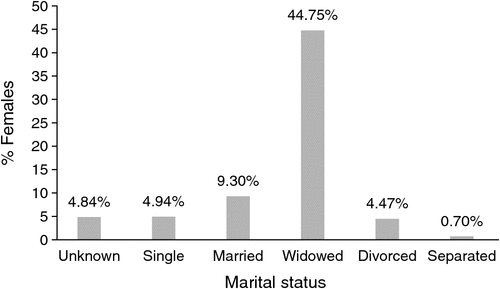
|
ATSI permanent residents
Only 0.039% of residents were recorded as ATSI; of these, 62% were women and this was consistent over the 3-year period. The largest percentage of ATSI residents were widowed females (30%); although this figure is lower than for non-ATSI counterparts, the difference did not reach statistical significance (χ2 = 2.739, d.f. = 1, P = 0.098).
Nationality of permanent residents
The largest percentage of residents (73%) were born in Australia, followed by residents originating from Europe (18.5%; Fig. 3). Smaller percentages of permanent residents originated from regions spanning the world. The percentage of residents originating from China, Europe, New Zealand and the UK increased over the 3-year period. All these changes were within 1 percentage point. The percentage of residents originating from other regions did not exhibit a clear trend over the study period (Fig. 3).
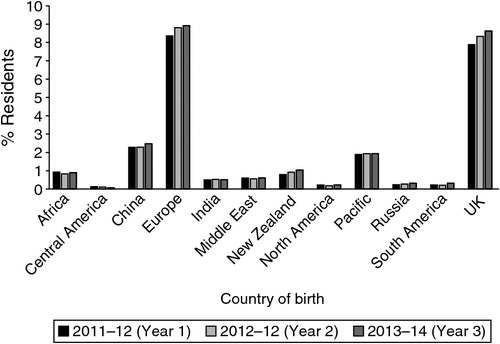
|
Care level of permanent residents
The percentage of residents in low care increased over the study period from 26.36% in Year 1 to 27.42% in Year 2 and 28.34% in Year 3. The percentage of residents admitted into low care increased overall, from 28.86% in Year 1 to 29.41% in Year 2 and 30.21% in Year 3. This was an increase of 1.35% in low care admissions. The percentage of low care residents who separated from the aged care facilities fluctuated from 25% in Year 1 to 26.7% in Year 2 and 22.9% in Year 3. The percentage of high care residents who separated (for all reasons) from the aged care facilities increased from 75% in Year 1 to 77% in Year 3.
LOS of permanent residents
The median LOS for permanent residents fluctuated from 1.73 years in Year 1 to 1.72 years in Years 2 and 3. These results were positively skewed across all three study years. Stratification revealed that 36% of permanent residents stayed in care 1 year or less (Fig. 4). Another 32% stayed in care for 1–3 years; the remaining 32% stayed in care for 3 years or longer. There was an upward trend in the percentage of residents staying ≤3 months or >5 years.
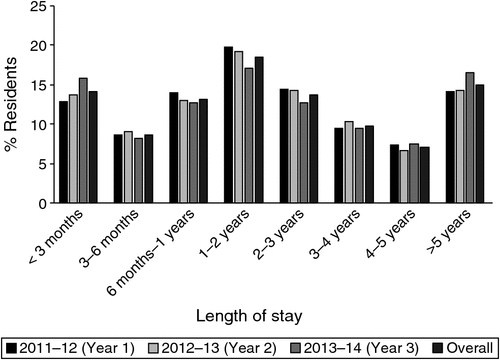
|
Single and widowed residents experienced the longest median LOS (1.98 years for both; range 23.92 and 26.04 respectively), which was significantly different compared with residents of other marital statuses (Mann–Whitney: z = 4.960, P < 0.001). Married and separated residents had the shortest median LOS (1.36 and 1.32 years respectively; range 19.11 and 13.86 respectively).
Median LOS of female residents (2.11 years; range 26.04 years) was significantly longer than that of males (1.33 years; range 20.17 years; Mann–Whitney: z = 11.312, P < 0.001).
ATSI residents experienced the shortest LOS (0.80 years; range 4.81) and this difference was statistically significant compared with non-ATSI residents (Mann–Whitney: z = 2.557, P = 0.011). There was no significant difference in the median LOS between residents in high care (1.88 years; range 26.04 years) and low care (1.6 years; range 23.91 years; Mann–Whitney: z = 1.441, P = 0.150).
There was no correlation between LOS and age at separation (R2 = 0.104).
Reason for departure or separation
Most (82%) residents separated from an aged care facility because they died (Fig. 5). The median age at death was higher than for residents who were discharged for other reasons (Fig. 6). The LOS for residents discharged to home or hospital decreased over the 3-year period, and this trend was statistically significant (Cuzick: hospital discharge: Cuzick: z = 3.22, P < 0.001; discharge home: z = 2.62, P = 0.009; Table 1). In contrast, residents who died experienced increased LOS over the 3-year period, but this trend did not reach statistical significance (Cuzick z = 1.76, P = 0.079).
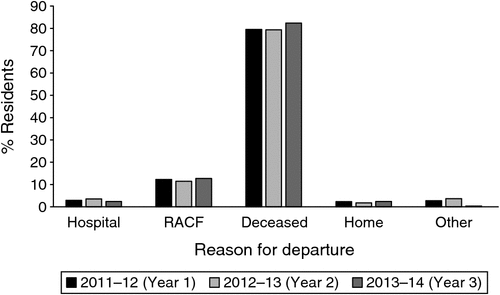
|
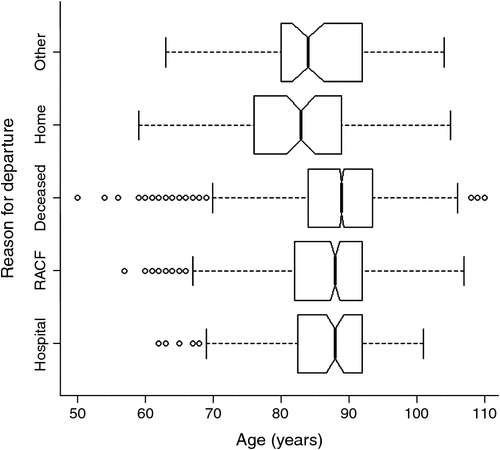
|
Discussion
The analyses in the present study revealed a clear demographic profile and consistent pattern of utilisation by residents in aged care facilities. One-third of permanent residents had resided in an aged care facility for 3 years or longer. Widowed females made up the majority of the residential aged care population, were the oldest residents, typically received high care and had the longest LOS. There was a modest decrease in high care utilisation over the time period evaluated. Just under 30% of residents were not born in Australia. ATSI residents made up less than 1% of the studied population. ATSI residents were younger and had shorter LOS than non-ATSI residents.
The trends in LOS are most intriguing. Andrews-Hall et al.16 evaluated national-level permanent resident data provided by the AIHW from 1998 to 2006 and found a median LOS of 1.6 years. The overall range was not specified, but residents requiring the most care had a median LOS of 1 year, whereas those requiring the least care had an LOS of 3.8–4 years. The Uniting residents had a median LOS of 1.72 years. High care residents stayed a median of 1.88 years (range 26.04), compared to 1.6 years (range 23.91) for low care residents. There was no statistically significant difference between Uniting high and low care residents. If it emerges that the Uniting data are nationally representative, this could indicate a significant demographic shift in the LOS and levels of care of permanent residents since 2006.
An important question is whether Uniting residents add to the overall picture of Australian aged care. To gain a sense of this, we used national level data on the age and ATSI status of permanent residents (see Methods) and found that the age profile of residents at Uniting did not differ significantly from the national profile of permanent residents over the 3-year period (Wilcoxon signed-rank test: Year 1 z = 1.014, P = 0.311; Year 2 z = 1.103, P = 0.270; Year 3 z = 1.183, P = 0.238; Fig. 7). National data were available only on the number of ATSI permanent residents aged 65 years and older across the 3 years of study, and statistical analyses could not be performed due to the small sample size of the Uniting ATSI population. The national AIHW data from 2011 to 2014 indicate that 35–38% of residents stay 1 year or less, 41–44% stay 1–5 years and the remaining 18–22% stay 5 years or longer.22 We were not able to analytically compare the AIHW data to the Uniting data, because the AIHW findings include respite residents. Further, the AIHW modified their methodology in 2013. Therefore, AIHW data may under-represent the contribution permanent residents make to these national residential aged care facility LOS data.
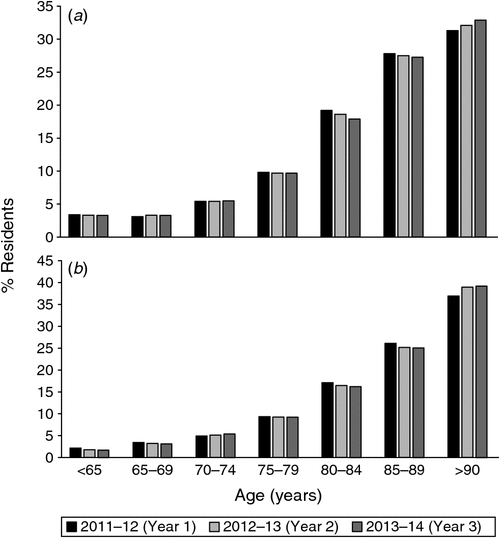
|
More generally, the increase in the percentage of residents aged 90 years or older (Fig. 7) is consistent with the finding that residents are separating from aged care facilities at greater median ages (Fig. 6). This supports the evidence that Australians are living longer.5 Most residents will die while in residential care and this reinforces the importance of providing end-of-life and palliative care services.4 Previous studies found that utilisation of residential aged care is not always correlated with age.23,24 We also found that LOS was not correlated with age.
The age distribution of the present study population matched that of the national residential aged population and so the findings of this study add to the overall picture of Australian residential aged care. However, the limited publicly available national data against which to compare the results of the present study hindered further analyses. This is a study limitation. Therefore, we tentatively conclude that it is possible that the utilisation and demographic trends discovered in the present study population could be indicative of national trends, but further national-level data would need to become publicly available to make a more definitive conclusion. This is critical, so that future studies can establish nationally representative findings and better inform practice and policy.
The findings of the present study could be used to better inform policy and the effects of changes in policy on aged care. There have been several changes in aged care policy over the decades, including the Aged Care Act of 1997 and the 2014 reforms. However, it is less clear whether the implemented policies have had the desired effects. For example, the recent implementation of HCPs is aimed, in part, to encourage aging at home. Based on the data analysed, we did not find changes that would be expected with implementation of HCPs: one would expect an increase in age on admission, a decrease in low care admissions or an increase in discharges to home care. Contrary to expectations, we found that age on admission remained constant over the 3-year period (86 years of age), low care admissions increased by 1.35% and that there was a statistically significant decrease in discharges home over the study period. We consider the present analysis tentative because, at the time of this study, HCPs were still being fully implemented. However, this point illustrates how these data can be applied to inform policy and its effectiveness.
Conclusion
The analyses herein revealed a clear demographic profile and consistent pattern of utilisation of aged care facilities. The most significant finding is that one-third of permanent residents had resided in an aged care facility for 3 years or longer. There have been several changes in aged care policy over the decades, including the Aged Care Act of 1997 and the 2014 reforms. However, it is still not clear whether these major policy changes have had the desired effects. The analyses outlined herein illustrate how community, health services and public health data can be used to inform policy, monitor progress and assess the effectiveness of aged care services. These findings add to the overall picture of Australian residential aged care.
Competing interests
None declared.
Acknowledgements
The authors thank Andrew Warland, Fleur Hourihan, Jessica Teh and Michelle Peatman of United Care Australia and Jenni Joenperä of the Australian Institute of Health and Welfare. This study was funded by an Australian Research Council linkage grant (LP120200815).
References
[1] Australian Institure of Health and Welfare. About ageing in Australia. 2016. Available at: http://www.aihw.gov.au/ageing/about/ [verified 9 June 2016].[2] World Health Organization (WHO). Good health adds life to years: global brief for World Health Day 2012. Geneva: WHO; 2012.
[3] Divo MJ, Martinez CH, Mannino DM. Ageing and the epidemiology of multimorbidity. Eur Respir J 2014; 44 1055–68.
| Ageing and the epidemiology of multimorbidity.Crossref | GoogleScholarGoogle Scholar |
[4] Phillips J, Davidson P, Jackson D, Kristjanson L, Daly J, Curran J. Residential aged care: the last frontier for palliative care. J Adv Nurs 2006; 55 416–24.
| Residential aged care: the last frontier for palliative care.Crossref | GoogleScholarGoogle Scholar |
[5] Richmond R. The changing face of the Australian population: growth in centenarians. Med J Aust 2008; 188 720–3.
[6] Quine S, Carter S. Australian baby boomers’ expectations and plans for their old age. Australas J Ageing 2006; 25 3–8.
| Australian baby boomers’ expectations and plans for their old age.Crossref | GoogleScholarGoogle Scholar |
[7] Australian Bureau of Statistics. Australia experiences lowest population growth in almost a decade. 2016. Available at: http://www.abs.gov.au/websitedbs/d3310114.nsf/home/australian+statistical+geography+standard+(asgs) [verified 9 June 2016].
[8] Australian Bureau of Statistics. Births registered, summary statistics for Australia. 2016. Available at: http://www.abs.gov.au/ausstats/abs@.nsf/mf/3301.0. [verified 9 June 2016].
[9] Australian Government Productivity Commission. Report on government services. Canberra: Australian Government Productivity Commission; 2015.
[10] Department of Social Services. 2012–13 Report on the operation of the Aged Care Act 1997. Canberra: Department of Social Services; 2014.
[11] Australian Government Productivity Commission. Report on government services. Canberra: Australian Government Productivity Commission; 2013.
[12] Australia Institute of Health and Welfare (AIHW). Residential aged care in Australia 2010–11: a statistical overview. Canberra: AIHW; 2012.
[13] Australian Institute of Health and Welfare. Recent reforms and initiatives in aged care. 2016. Available at: http://www.aihw.gov.au/aged-care/reforms/ [verified 9 June 2016].
[14] Department of Social Services. Ageing and aged care. What has been achieved so far. 2016. Available at: https://www.dss.gov.au/ageing-and-aged-care-aged-care-reform/what-has-been-achieved-so-far [verified 9 June 2016].
[15] Australian Government. My aged care: home care packages. 2015. Available at: http://www.myagedcare.gov.au/aged-care-services/home-care-packages [verified 9 June 2016].
[16] Andrews-Hall S, Howe A, Robinson A. The dynamics of residential aged care in Australia: 8-year trends in admission, separations and dependency. Aust Health Rev 2007; 31 611–22.
| The dynamics of residential aged care in Australia: 8-year trends in admission, separations and dependency.Crossref | GoogleScholarGoogle Scholar |
[17] Australian Bureau of Statistics. Australian Statistical Geography Standard. Available at: http://www.abs.gov.au/websitedbs/d3310114.nsf/home/australian+statistical+geography+standard+(asgs) [verified 7 October 2016].
[18] Australian Department of Health and Ageing. Aged care funding instrument (ACFI) – user guide. Canberra: Australian Department of Health and Ageing; 2013.
[19] Australian Government Productivity Commission. Report on government services. Canberra: Australian Government Productivity Commission; 2014.
[20] Chambers JM. Graphical methods for data analysis. Boston: Wadsworth International Group; 1983.
[21] Cuzick J. A Wilcoxon‐type test for trend. Stat Med 1985; 4 543–7.
| A Wilcoxon‐type test for trend.Crossref | GoogleScholarGoogle Scholar |
[22] Australian Institute of Health and Welfare. Ageing. 2016. Available at: http://www.aihw.gov.au/ageing/ [verified 9 June 2016].
[23] Broad JB, Boyd M, Kerse N, Whitehead N, Chelimo C, Lay-Yee R, von Randow M, Foster S, Connolly MJ. Residential aged care in Auckland, New Zealand 1988–2008: do real trends over time match predictions? Age Ageing 2011; 40 487–94.
| Residential aged care in Auckland, New Zealand 1988–2008: do real trends over time match predictions?Crossref | GoogleScholarGoogle Scholar |
[24] Ribbe MW, Ljunggren G, Steel K, Topinkova E, Hawes C, Ikegami N, Henrard J-C, Jonnson PV. Nursing homes in 10 nations: a comparison between countries and settings. Age Ageing 1997; 26 3–12.
| Nursing homes in 10 nations: a comparison between countries and settings.Crossref | GoogleScholarGoogle Scholar |




